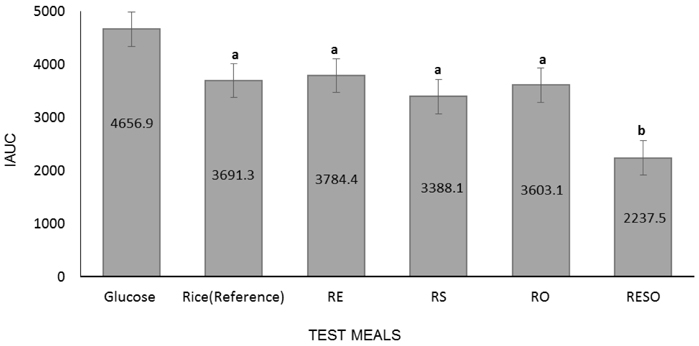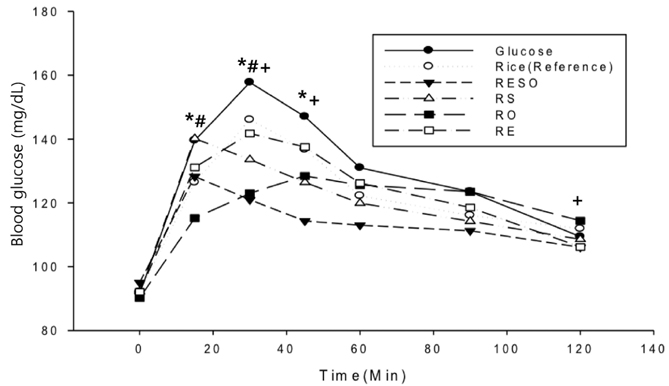Nutr Res Pract.
2019 Apr;13(2):126-133. 10.4162/nrp.2019.13.2.126.
Effect of nutrient composition in a mixed meal on the postprandial glycemic response in healthy people: a preliminary study
- Affiliations
-
- 1Department of Foods and Nutrition, Kookmin University, 77 Jeongneung-ro, Seongbuk-gu, Seoul 02707, Korea. schung@kookmin.ac.kr
- 2Corporate Technology Office, Pulmuone Co., Ltd, Seoul 06367, Korea.
- 3Department of Food and Nutrition, University of Georgia, Athens, GA 30602, USA.
- KMID: 2442369
- DOI: http://doi.org/10.4162/nrp.2019.13.2.126
Abstract
- BACKGROUND/OBJECTIVES
The glycemic index (GI) is a measure of the postprandial glucose response (PPGR) to food items, and glycemic load (GL) is a measure of the PPGR to the diet. For those who need to maintain a healthy diet, it is beneficial to regulate appropriate levels of blood glucose. In reality, what influences the meal GI or GL depends on the macronutrient composition and the physical chemistry reactions in vivo. Thus, we investigated whether different macronutrients in a meal significantly affect the PPGR and the validity of calculated GI and GL values for mixed meals.
SUBJECTS/METHODS
12 healthy subjects (6 male, 6 female) were recruited at a campus setting, and subjects consumed a total of 6 test meals one by one, each morning between 8:00 and 8:30 am after 12 h of fasting. PPGR was measured after each consumed meal and serial finger pricks were performed at indicated times. Test meals included 1) 68 g oral glucose, 2) 210 g rice, 3) rice plus 170 g egg white (RE), 4) rice plus 200 g bean sprouts (RS), 5) rice plus 10 g oil (RO), and 6) rice plus, egg white, bean sprouts, and oil (RESO). The incremental area under the curve (iAUC) was calculated to assess the PPGR. Mixed meal GI and GL values were calculated based on the nutrients the subjects consumed in each of the test meals.
RESULTS
The iAUC for all meals containing two macronutrients (RS, RO, or RE) were not significantly different from the rice iAUC, whereas, the RESO iAUC (2,237.5 ± 264.9) was significantly lower (P < 0.05). The RESO meal's calculated GI and GL values were different from the actual GI and GL values measured from the study subjects (P < 0.05).
CONCLUSIONS
The mixed meal containing three macronutrients (RESO) decreased the PPGR in healthy individuals, leading to significantly lower actual GI and GL values than those derived by nutrient-based calculations. Thus, consuming various macronutrient containing meals is beneficial in regulating PPGR.
Keyword
MeSH Terms
Figure
Reference
-
1. Wolever TM, Jenkins DJ. The use of the glycemic index in predicting the blood glucose response to mixed meals. Am J Clin Nutr. 1986; 43:167–172.
Article2. McMillan-Price J, Petocz P, Atkinson F, O'neill K, Samman S, Steinbeck K, Caterson I, Brand-Miller J. Comparison of 4 diets of varying glycemic load on weight loss and cardiovascular risk reduction in overweight and obese young adults: a randomized controlled trial. Arch Intern Med. 2006; 166:1466–1475.
Article3. Barclay AW, Petocz P, McMillan-Price J, Flood VM, Prvan T, Mitchell P, Brand-Miller JC. Glycemic index, glycemic load, and chronic disease risk--a meta-analysis of observational studies. Am J Clin Nutr. 2008; 87:627–637.
Article4. Brand-Miller J, Hayne S, Petocz P, Colagiuri S. Low-glycemic index diets in the management of diabetes: a meta-analysis of randomized controlled trials. Diabetes Care. 2003; 26:2261–2267.
Article5. Wolever TM, Jenkins DJ, Vuksan V, Jenkins AL, Wong GS, Josse RG. Beneficial effect of low-glycemic index diet in overweight NIDDM subjects. Diabetes Care. 1992; 15:562–564.
Article6. Camps SG, Kaur B, Quek RY, Henry CJ. Does the ingestion of a 24 hour low glycaemic index Asian mixed meal diet improve glycaemic response and promote fat oxidation? A controlled, randomized cross-over study. Nutr J. 2017; 16:43.
Article7. Frost G, Leeds A, Trew G, Margara R, Dornhorst A. Insulin sensitivity in women at risk of coronary heart disease and the effect of a low glycemic diet. Metabolism. 1998; 47:1245–1251.
Article8. Sacks FM, Carey VJ, Anderson CA, Miller ER 3rd, Copeland T, Charleston J, Harshfield BJ, Laranjo N, McCarron P, Swain J, White K, Yee K, Appel LJ. Effects of high vs low glycemic index of dietary carbohydrate on cardiovascular disease risk factors and insulin sensitivity: the OmniCarb randomized clinical trial. JAMA. 2014; 312:2531–2541.
Article9. Krebs JD, Bell D, Hall R, Parry-Strong A, Docherty PD, Clarke K, Chase JG. Improvements in glucose metabolism and insulin sensitivity with a low-carbohydrate diet in obese patients with type 2 diabetes. J Am Coll Nutr. 2013; 32:11–17.
Article10. Dodd H, Williams S, Brown R, Venn B. Calculating meal glycemic index by using measured and published food values compared with directly measured meal glycemic index. Am J Clin Nutr. 2011; 94:992–996.
Article11. Jenkins DJ, Wolever TM, Taylor RH, Barker H, Fielden H, Baldwin JM, Bowling AC, Newman HC, Jenkins AL, Goff DV. Glycemic index of foods: a physiological basis for carbohydrate exchange. Am J Clin Nutr. 1981; 34:362–366.
Article12. Jenkins DJ, Wolever TM, Jenkins AL, Lee R, Wong GS, Josse R. Glycemic response to wheat products: reduced response to pasta but no effect of fiber. Diabetes Care. 1983; 6:155–159.
Article13. Hamberg O, Rumessen JJ, Gudmand-Høyer E. Blood glucose response to pea fiber: comparisons with sugar beet fiber and wheat bran. Am J Clin Nutr. 1989; 50:324–328.
Article14. Fajans SS, Floyd JC Jr, Knopf RF, Conn FW. Effect of amino acids and proteins on insulin secretion in man. Recent Prog Horm Res. 1967; 23:617–662.
Article15. Gannon MC, Nuttall FQ, Saeed A, Jordan K, Hoover H. An increase in dietary protein improves the blood glucose response in persons with type 2 diabetes. Am J Clin Nutr. 2003; 78:734–741.
Article16. Cunningham KM, Read NW. The effect of incorporating fat into different components of a meal on gastric emptying and postprandial blood glucose and insulin responses. Br J Nutr. 1989; 61:285–290.
Article17. Bell KJ, Smart CE, Steil GM, Brand-Miller JC, King B, Wolpert HA. Impact of fat, protein, and glycemic index on postprandial glucose control in type 1 diabetes: implications for intensive diabetes management in the continuous glucose monitoring era. Diabetes Care. 2015; 38:1008–1015.
Article18. Josse AR, Kendall CW, Augustin LS, Ellis PR, Jenkins DJ. Almonds and postprandial glycemia--a dose-response study. Metabolism. 2007; 56:400–404.
Article19. Miller JB, Pang E, Bramall L. Rice: a high or low glycemic index food? Am J Clin Nutr. 1992; 56:1034–1036.
Article20. Wolever TM. Is glycaemic index (GI) a valid measure of carbohydrate quality? Eur J Clin Nutr. 2013; 67:522–531.
Article21. Hätönen KA, Virtamo J, Eriksson JG, Sinkko HK, Sundvall JE, Valsta LM. Protein and fat modify the glycaemic and insulinaemic responses to a mashed potato-based meal. Br J Nutr. 2011; 106:248–253.
Article22. Sun L, Ranawana DV, Leow MK, Henry CJ. Effect of chicken, fat and vegetable on glycaemia and insulinaemia to a white rice-based meal in healthy adults. Eur J Nutr. 2014; 53:1719–1726.
Article23. Monro JA, Shaw M. Glycemic impact, glycemic glucose equivalents, glycemic index, and glycemic load: definitions, distinctions, and implications. Am J Clin Nutr. 2008; 87:237S–243S.
Article24. Ito Y, Mizukuchi A, Kise M, Aoto H, Yamamoto S, Yoshihara R, Yokoyama J. Postprandial blood glucose and insulin responses to pre-germinated brown rice in healthy subjects. J Med Invest. 2005; 52:159–164.
Article25. Wolever TM, Jenkins DJ, Jenkins AL, Josse RG. The glycemic index: methodology and clinical implications. Am J Clin Nutr. 1991; 54:846–854.
Article26. Kim EK, Lee JS, Hong H, Yu CH. Association between glycemic index, glycemic load, dietary carbohydrates and diabetes from Korean National Health and Nutrition Examination Survey 2005. Korean J Nutr. 2009; 42:622–630.
Article27. World Health Organization. Definition and Diagnosis of Diabetes Mellitus and Intermediate Hyperglycemia: Report of a WHO/IDF Consultation. Geneva: World Health Organization;2006. p. 1–50.28. Brouns F, Bjorck I, Frayn KN, Gibbs AL, Lang V, Slama G, Wolever TM. Glycaemic index methodology. Nutr Res Rev. 2005; 18:145–171.
Article29. Foster-Powell K, Holt SH, Brand-Miller JC. International table of glycemic index and glycemic load values: 2002. Am J Clin Nutr. 2002; 76:5–56.
Article30. Sugiyama M, Tang AC, Wakaki Y, Koyama W. Glycemic index of single and mixed meal foods among common Japanese foods with white rice as a reference food. Eur J Clin Nutr. 2003; 57:743–752.
Article31. Collier GR, Wolever TM, Wong GS, Josse RG. Prediction of glycemic response to mixed meals in noninsulin-dependent diabetic subjects. Am J Clin Nutr. 1986; 44:349–352.
Article32. Bornet FR, Costagliola D, Rizkalla SW, Blayo A, Fontvieille AM, Haardt MJ, Letanoux M, Tchobroutsky G, Slama G. Insulinemic and glycemic indexes of six starch-rich foods taken alone and in a mixed meal by type 2 diabetics. Am J Clin Nutr. 1987; 45:588–595.
Article33. Gulliford MC, Bicknell EJ, Scarpello JH. Differential effect of protein and fat ingestion on blood glucose responses to high- and low-glycemic-index carbohydrates in noninsulin-dependent diabetic subjects. Am J Clin Nutr. 1989; 50:773–777.
Article34. Henry CJ, Lightowler HJ, Kendall FL, Storey M. The impact of the addition of toppings/fillings on the glycaemic response to commonly consumed carbohydrate foods. Eur J Clin Nutr. 2006; 60:763–769.
Article35. Wolever TM, Bhaskaran K. Use of glycemic index to estimate mixed-meal glycemic response. Am J Clin Nutr. 2012; 95:256–257.
Article36. Moghaddam E, Vogt JA, Wolever TM. The effects of fat and protein on glycemic responses in nondiabetic humans vary with waist circumference, fasting plasma insulin, and dietary fiber intake. J Nutr. 2006; 136:2506–2511.
Article37. Gentilcore D, Chaikomin R, Jones KL, Russo A, Feinle-Bisset C, Wishart JM, Rayner CK, Horowitz M. Effects of fat on gastric emptying of and the glycemic, insulin, and incretin responses to a carbohydrate meal in type 2 diabetes. J Clin Endocrinol Metab. 2006; 91:2062–2067.
Article38. Imai S, Fukui M, Kajiyama S. Effect of eating vegetables before carbohydrates on glucose excursions in patients with type 2 diabetes. J Clin Biochem Nutr. 2014; 54:7–11.
Article39. Academy of Nutrition and Dietetic. How to Explain Basic Nutrition Concepts [Internet]. Chicago, IL: Academy of Nutrition and Dietetic;2018. cited 2018 May 11. Available from: https://www.eatrightpro.org/practice/practice-resources/international-nutrition-pilot-project/how-to-explain-basic-nutrition-concepts.
- Full Text Links
- Actions
-
Cited
- CITED
-
- Close
- Share
- Similar articles
-
- Short-Term Effect of Convenience Meal Intake on Glycemic Response and Satiety among Healthy College Students in South Korea
- The Effects of Diet on the Symptoms and Gastric Electrical Activities for Patients with Functional Dyspepsia
- Effects of macronutrients in mixed meals on postprandial glycemic response
- Effect of Nutrient Preload and Food Order on Glucose, Insulin, and Gut Hormones
- Utility of the Glycemic Index in Practical Diabetes Management



